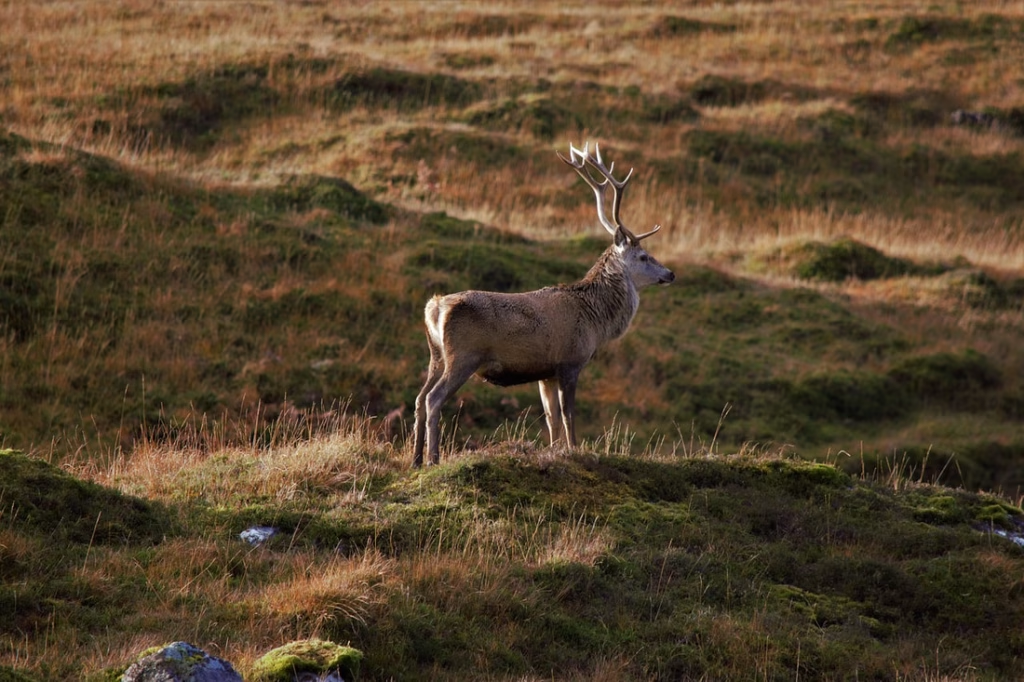Deer Stalking and Rewilding

Deer-stalking and rewilding are more closely intertwined than many may think, with arguable positives and negatives. Deer-stalking, more than any other kind of hunting, highlights some of the key issues that rewilding faces.
The number of 2 million deer is often thrown around while discussing deer population in the UK, but the truth is that no one really knows the true number. However, it is clear that deer can have a devastating effect on growing vegetation, browsing saplings and scrub down to the earth, and stags rubbing their antlers on trees can kill the tree. While trees have co-evolved with deer and can even benefit from browsing pressure, due to the high level of deer, or the lack of predators to keep them moving, the pressure is too great. This is leading to ageing forests with no new trees to replace the mature trees as they age and die, as well as denuded landscapes (compounded by sheep grazing).
Apex predators such as wolves create what is known as a ‘landscape of fear’. The numbers of deer directly affected by predation are relatively low, but the presence of an apex predator will keep the deer moving, they won’t stay to browse until they’ve eaten all the vegetation. Less fawns would be born and the deer population has a lower population balance with the predators. What we are seeing in the UK is what happens when there are no wolves or bears to keep the numbers in check. A great example of this is when wolves were reintroduced to Yellowstone, and had an incredibly positive effect on the ecosystem.
Some rewilding and nature restoration projects use deer fencing to ring off areas of vegetation and woodland, allowing it to ‘pulse’ and grow until it reaches a point where it can handle browsing. However, deer are amazing at leaping fences, so deer fencing is very high and very expensive, creating visible barriers on the land, can cause problems for other animals and requires a serious financial investment. The results are incredible, but sometimes this option is out of reach for small projects.
Another option is deer-stalking. The benefits to this is that it allows some browsing in an area to allow natural processes to continue, and without the capital investment in fencing. It’s a difficult thing to get your head around. Deer are among the last truly wild large mammals we have in the wild in Britain, and moments of encountering them that can be charged with wonder. However the damage they’re doing is undeniable, and those that do this work can see themselves as replacing the apex predator function in the ecosystem.
I spoke to Bernard Davies, who works for a rewilding project, and culls deer through deer-stalking as a part of his job;
“I got into deer stalking because the previous estate had a lot of muntjac, which are an invasive and non-native deer, and so in order to be able to start restoring the ecosystem there I had to control the muntjac, which I shot and ensured that nothing went to waste by sharing among friends and family and eating the venison myself. Having always worked with […] animals, I empathise with animals and I would never want to inflict any kind of suffering upon any animal. I think that by stalking them, they never really know what happens. […] whilst I don’t particularly like killing, I view it as a necessary evil, […] because the deer populations are not under control and they do put the rest of the ecosystem out of balance, which is entirely due to the absence of apex predators… I do view my role as a stand-in apex predator with regards to deer stalking… I just don’t see (apex predator reintroduction) happening in the near future. So I think deer stalking is going to be an ongoing requirement.’
There is another side to this though, away from the rewilding and nature restoration work, and the need to allow space for woodland and scrub to renew. The other side to this is the huge amount of deer-stalking estates in the UK. These are privately owned estates, heavily managed to provide the ‘perfect’ environment to keep and hunt deer. They are often on uplands prime for rewilding, often in a degraded condition due to the management and over-browsing, feeding deer overwinter to keep their numbers high just to be shot.
These estates are owned by the wealthy and are maintained for the wealthy to shoot at. They add nothing to the local economy either in money or jobs, especially compared to what rewilding does. The actual amount of land given over to this bloodsport is unknown, land ownership and management deliberately hidden, however there is a clearly a huge amount of land given to this ecologically-degrading and economically unviable bloodsport, where instead we could see land returned to nature, such as this Scottish estate, while still acknowledging the need to balance the deer population.
And all the while, we need to be looking at restoring functioning natural processes, by reintroducing apex predators like wolves, which would then keep the deer population low and mobile, allowing our forests to regenerate and boost biodiversity.
Our blog posts are written by our core team and guest bloggers. If you have an idea for a blog post please pitch it to us: info@wildcard.land
ARCHIVES
- November 2025
- October 2025
- September 2025
- August 2025
- July 2025
- June 2025
- May 2025
- April 2025
- March 2025
- February 2025
- December 2024
- November 2024
- October 2024
- September 2024
- August 2024
- July 2024
- June 2024
- March 2024
- February 2024
- January 2024
- December 2023
- November 2023
- August 2023
- July 2023
- May 2023
- February 2023
- January 2023
